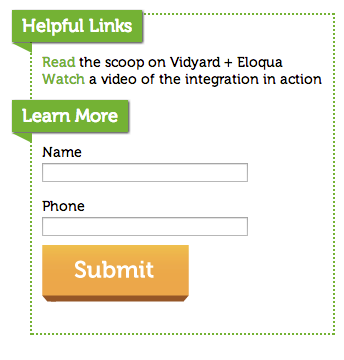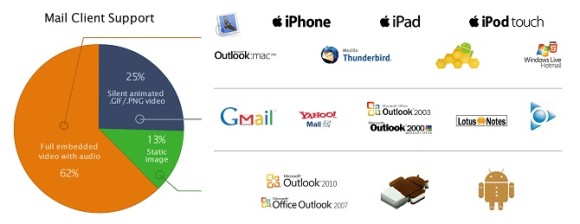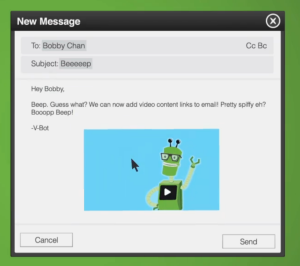Email campaigns are a great way to share your video content, but people are still a bit unsure about how to include video effectively. In this post I’ll share some tips and tricks to help everybody add the special sauce and really amp up their nurturing campaigns.

The Top Question about Video in Email Marketing
A lot of people ask me “Ian, can I stream video playback in an email?”. The answer to this question is sort of. The image below outlines which email clients support video, but as you’ll notice, you have to be careful with this pie chart. Because the two major email clients (Outlook and Gmail) do not support video playback, you have to get a bit creative to give your readers an interactive video experience.
That said, here’s my 4 tips to work around the playback challenge and incorporate video in your emails:
1. Within your email, include an image from your video and put a play button over top of it to mimic the look of a typical video player:
Here you’re adding a visual indication that a video is part of your email with the play button. When readers are prompted with this play button, they’ll click the image and be directed to a landing page – or a branded video sharing page – with your video embedded. Using a compelling image to link readers to your video content within email works really well to increase click through rates.
You can also use a GIF instead of a static image; however, you should choose an ideal first image for the GIF in case the email client does not support GIFs (darn Outlook), and freezes at the first image.
2. Embed video on your landing page and set it to auto-play:
Because you’re technically redirecting folks to a landing page with your video embedded, you’ll want to catch their attention right away and auto-play is a surefire way to do this (it also requires less clicks from your viewers).
3. As a general guideline, your video should be 30-90 seconds for top of funnel campaigns and 1-30 minutes for individuals further down the funnel:
Because attention spans will vary depending on a prospect’s progression through the sales funnel, you’ll want to make sure your emails, and the videos within those email campaigns, are highly targeted.
When sending communication to top-of-funnel leads, the associated video should be short and sweet and doesn’t necessarily have to go into product details. The whole point is to attract new contacts and guide them into the sales funnel.
For prospects you’re targeting who are further along in the funnel, consider including videos to answer questions you know they have about the product, detailed product demos, or personalized videos about how the product solves problems within their industry.
4. Place a call to action during, or at the end of the video that suggests a clear next step for your audience:
If you’ve managed to get your readers to become viewers, you’ll definitely want to direct your them to more content they might like, encourage them to share the video with social buttons, or have them fill out an Eloqua form at the end of the video.
Building a call to action can be as simple as prompting viewers to “download our white paper” or as strategic as including a contact form at the end of a video. A form can collect even more details to push into your marketing automation or CRM contact records for future lead nurturing and segmentation.
Here’s an example CTA I built for the end of a video:

You can also check out some best practices for video CTAs by my buddy Micheal Litt in his Demanding Views post.
Tracking & Measuring your campaign
You can send as many emails as you want, but if you aren’t tracking responses, you won’t know if your videos are effective or not. All email marketing systems can tell you who’s clicked on your email, and which links they clicked within the email – video or otherwise. Tracking beyond this info is where things get more interesting.
For our video campaigns, we use Vidyard to track not only who watches the video, but how long each individual viewer watched our video and where they dropped off or lost interest. For instance, if Steve watches our home page video, but never returns to our site, it’s safe to assume he was not as engaged with our content as Monica, who watched our Eloqua integration video, visited our blog, and watched more video content on our Space Academy.
Capture new leads with forwarded emails
If someone really likes your email/video they may forward it to a friend.
If their friend’s contact information isn’t stored in your marketing automation or customer relationship management system, you’ll want to make sure there’s some way for this new contact to put up their hand and request more information.
Vidyard offers email gates that can be added before the video plays and customizable calls-to-action that follow the video wherever it’s viewed. Optimizations like this can help you capture lead data anywhere your video goes, and it’s important to have this sort of strategy for capturing information from viewers who want to self-identify as interested prospects.
Easily Creating Video for Email
While recording and sharing video through email hasn’t always been easy, new tools like ViewedIt have emerged to allow marketers, support professionals, and salespeople to take advantage of this powerful medium.
ViewedIt is a free Chrome plug-in that allows you to record your screen, a specific tab, or your camera and automatically attach that to an email in Gmail or Google Apps. You’ll be able to see who watched the content, how much, and whether they re-watched portions of the content. It’s perfect for quickly sharing a video voicemail with a potential customer, putting together a walk-through to answer a support inquiry, or sending out a CEO update or internal news to your team.
Oh the places your video will go!
What if someone likes your content so much that they publish it elsewhere (blog, press, social media etc.)? Or if they use your video within re-published content? Well, the same functionality will apply. You still get all the data, lead generation, and the built in calls to action regardless of where your video ends up out on the Internet. This applies to YouTube annotations, and Vidyard’s calls-to-action.
If you’re using video in your email campaigns, how’s it working? How are you tracking your success? What’s your average click through rate when you include videos? Tell me in the comments below – I’d love to hear about what’s working and if you find these tips helpful!
The post How to use Video in your Email Marketing Campaigns appeared first on Vidyard.
source http://www.vidyard.com/blog/how-to-use-video-in-email-marketing/



No comments:
Post a Comment